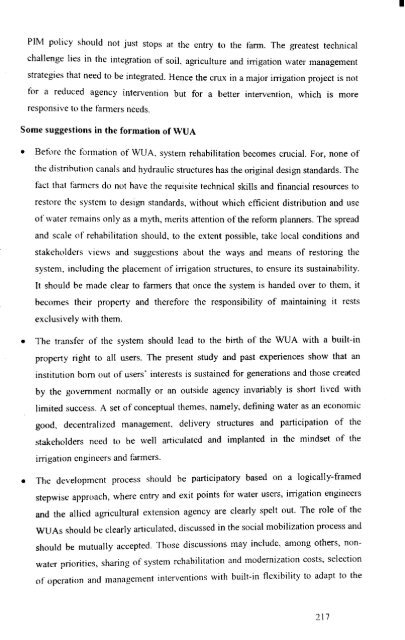Water Users Association and Irrigation Management - Institute for ...
Water Users Association and Irrigation Management - Institute for ...
Water Users Association and Irrigation Management - Institute for ...
Create successful ePaper yourself
Turn your PDF publications into a flip-book with our unique Google optimized e-Paper software.
•<br />
PIM policy should not just stops at the entry to the fann. The greatest technical<br />
challenge lies in the integration of soil, agriculture <strong>and</strong> irrigation water management<br />
strategies that need to be integrated. Hence the crux in a major irrigation project is not<br />
<strong>for</strong> a reduced agency intervention but <strong>for</strong> a better intervention, which is more<br />
responsive to the fanners needs.<br />
Some suggestions in the <strong>for</strong>mation ofWUA<br />
• Be<strong>for</strong>e the tlmnation of WUA, system rehabilitation becomes crucial. For, none of<br />
the distrihution canals <strong>and</strong> hydraulic structures has the original design st<strong>and</strong>ards. The<br />
fact that fanncrs do not have the requisite technical skills <strong>and</strong> financial resources to<br />
restore the system to design st<strong>and</strong>ards, without which efficient distribution <strong>and</strong> use<br />
of water remains only as a myth, merits attention of the refonn planners. The spread<br />
<strong>and</strong> scale of rehabilitation should, to the extent possible, take local conditions <strong>and</strong><br />
stakeholders views <strong>and</strong> suggestions about the ways <strong>and</strong> means of restoring the<br />
system, including the placement of irrigation structures, to ensure its sustainability.<br />
It should be made clear to fanners that once the system is h<strong>and</strong>ed over to them, it<br />
becomes their property <strong>and</strong> there<strong>for</strong>e the responsibility of maintaining it rests<br />
exclusively with them.<br />
• The transfer of the system should lead to the birth of the WUA with a built-in<br />
property right to all users. The present study <strong>and</strong> past experiences show that an<br />
institution born out of users' interests is sustained <strong>for</strong> generations <strong>and</strong> those cremed<br />
by the government nonnally or an outside agency invariably is short lived with<br />
limited success. A set of conceptual themes, namely, defining water as an economic<br />
good, decentralized management, delivery structures <strong>and</strong> participation of the<br />
stakeholders need to be well articulated <strong>and</strong> implanted in the mindset of the<br />
irrigation engineers <strong>and</strong> fanners.<br />
• The development process should be participatory based on a logically-framed<br />
stepwise approach, where entry <strong>and</strong> exit points <strong>for</strong> water users, irrigation engineers<br />
<strong>and</strong> the allied agricultural extension agency are clearly spelt out. The role of the<br />
WUAs should he clearly articulated, discussed in the social mobilization process <strong>and</strong><br />
should be mutually accepted. Those discussions may include, among others, nonwater<br />
priorities, sharing of system rchahilitation <strong>and</strong> modernization costs, selection<br />
of operation <strong>and</strong> management interventions with huilt-in flexibility to adapt to the<br />
217
















